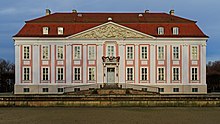
Potsdam is the capital and largest city of the German state of Brandenburg. It is part of the Berlin/Brandenburg Metropolitan Region. Potsdam sits on the River Havel, a tributary of the Elbe, downstream of Berlin, and lies embedded in a hilly morainic landscape dotted with many lakes, around 20 of which are located within Potsdam's city limits. It lies some 25 kilometres southwest of Berlin's city centre. The name of the city and of many of its boroughs are of Slavic origin.

Neuruppin is a town in Brandenburg, Germany, the administrative seat of Ostprignitz-Ruppin district. It is the birthplace of the novelist Theodor Fontane (1819–1898) and therefore also referred to as Fontanestadt. A garrison town since 1688 and largely rebuilt in a Neoclassical style after a devastating fire in 1787, Neuruppin has the reputation of being "the most Prussian of all Prussian towns".
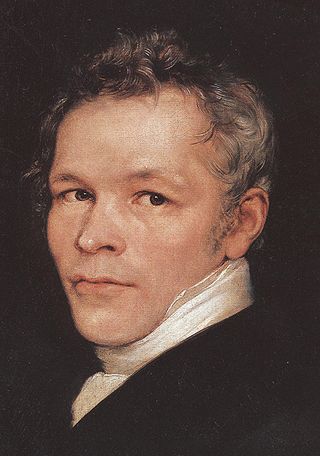
Karl Friedrich Schinkel was a Prussian architect, city planner and painter who also designed furniture and stage sets. Schinkel was one of the most prominent architects of Germany and designed both Neoclassical and neo-Gothic buildings. His most famous buildings are found in and around Berlin.

Charlottenburg is a locality of Berlin within the borough of Charlottenburg-Wilmersdorf. Established as a town in 1705 and named after Sophia Charlotte of Hanover, Queen consort of Prussia, it is best known for Charlottenburg Palace, the largest surviving royal palace in Berlin, and the adjacent museums.
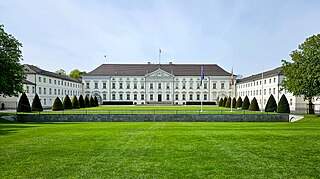
Bellevue Palace, located in Berlin's Tiergarten district, has been the official residence of the president of Germany since 1994. The schloss is situated on the banks of the Spree river, near the Berlin Victory Column, along the northern edge of the Großer Tiergarten park. Its name – the French for "beautiful view" – derives from its scenic prospect over the Spree's course.

Schloss Charlottenburg is a Baroque palace in Berlin, located in Charlottenburg, a district of the Charlottenburg-Wilmersdorf borough, and is among the largest palaces in the world.

Peter Joseph Lenné was a Prussian gardener and landscape architect. As director general of the Royal Prussian palaces and parks in Potsdam and Berlin, his work shaped the development of 19th-century German garden design in the Neoclassical style. Laid out according to the principles of the English landscape garden, his parks are now World Heritage Sites.
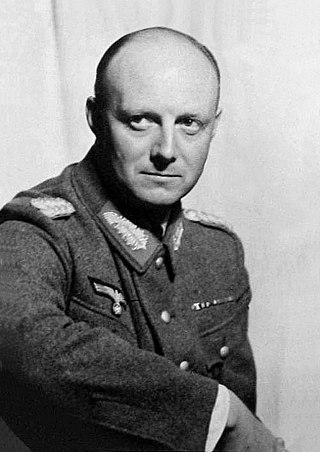
Tresckow is a German aristocratic family originating from Mark Brandenburg and belonging to the German nobility dating back to the middle ages. A prominent branch of the family is known as Treskow and acquired substantial land and wealth in the 18th and 19th century.

Friedrich August Stüler was an influential Prussian architect and builder. His masterpiece is the Neues Museum in Berlin, as well as the dome of the triumphal arch of the main portal of the Berliner Schloss.

Neuhardenberg is a municipality in the district Märkisch-Oderland, in Brandenburg, Germany. It is the site of Neuhardenberg Palace, residence of the Prussian statesman Prince Karl August von Hardenberg (1750–1822). The municipal area comprises the villages of Altfriedland, Quappendorf and Wulkow. Neuhardenberg is part of the Amt Seelow-Land.

Paul Ludwig Simon, also known as Paul Louis Simon, was a German architect and professor at the Building Academy (Bauakademie) in the faculty of architectural physics and a privy architectural counsellor at the Prussian Higher Council of Architecture in Berlin. In the latter position Simon was the predecessor of Karl Friedrich Schinkel. Simon was serving as well as Senior Director of public works for the Marches of Pomerania and Prussia. Beside these fields of activity Simon did – at that time in Europe well known – research work in the field of Electrochemistry and Galvanism. He published different articles on these subjects in German scientific journals – as for example “Annals of Physics”.
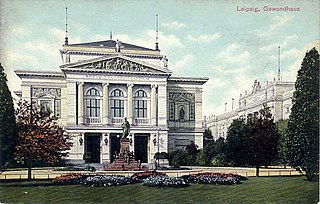
Martin Carl Philipp Gropius was a German architect.

Jelenia Góra Valley in Poland is a big valley at the Silesian northern side of the Western Sudetes and next to Kłodzko Valley the largest intermontane basin of the Sudetes. It is situated at an altitude of 250–400 meters above sea level and covers an area of 273 km2. In the 19th century, the lovely landscape attracted the Prussian high nobility, which built magnificent palaces, manors and parks. The enormous number of stately homes turned the valley into one of the most important garden landscapes in Middle Europe.

Albrechtsberg Palace or Albrechtsberg Castle is a Neoclassical stately home above the Elbe river in the Loschwitz district of Dresden. It was erected in 1854 according to plans designed by the Prussian court and landscaping architect Adolf Lohse (1807–1867) at the behest of Prince Albert, younger brother of the Prussian king Frederick William IV.

The House of Egloffstein is an ancient Franconian aristocratic family (Uradel) with an eponymous family home in the hill region of Franconian Switzerland in the Bavarian province of Upper Franconia. The family first appears in the records in 1187 with a Heinrich genannt Stuchs who is also the progenitor. The house belongs to the brotherhood of Franconian Imperial Knights. Egloffstein Castle and Kunreuth Castle are to this day owned by the family.
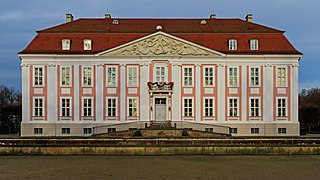
The Friedrichsfelde Palace is a Neoclassical-style building in the centre of the Tierpark Berlin in Berlin-Friedrichsfelde. It was property of various noble Prussians and occasionally owned by Prussian Kings. The last owners were the Treskow family, whose landmarked family burial ground is located in the surrounding park. Currently, the palace offers exhibitions about its history and is a place for classical concerts and cultural events.

Treskowallee is a large boulevard in Berlin, Germany. It runs through the boroughs of Lichtenberg and Treptow-Köpenick and is home to many landmark buildings and institutions, such as the Berlin School of Engineering and Economics (HTW) and the Karlshorst horseracing track. Between 2013 and 2015, a neighborhood named Treskow Höfe was developed along the northern end of the avenue. It is named for the Treskow family.

The Treskow family burial ground is a historic landmark in Berlin, Germany. It was established in 1821 by Carl Sigismund von Treskow for his family, a branch of the von Treskow noble family, and is located in the park of Friedrichsfelde Palace in the Friedrichsfelde district.

Friedrichstein Palace (German: Schloss Friedrichstein was a baroque palace near Königsberg, East Prussia. It was designed by Jean de Bodt, and constructed between 1709 and 1714. The palace was the main residence of the Dönhoff family.

The Owińska Palace is a palace in the village of Owińska, Poznań County, Greater Poland Voivodeship, Poland. The palace complex, including its two gates and the surrounding park, is included into the register of immovable cultural property of the Greater Poland Voivodship.

